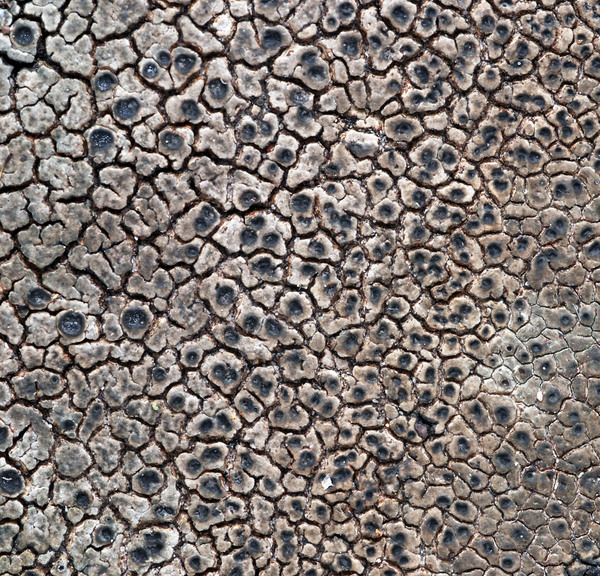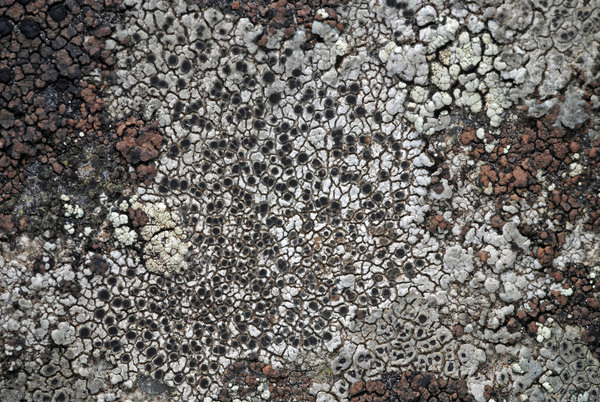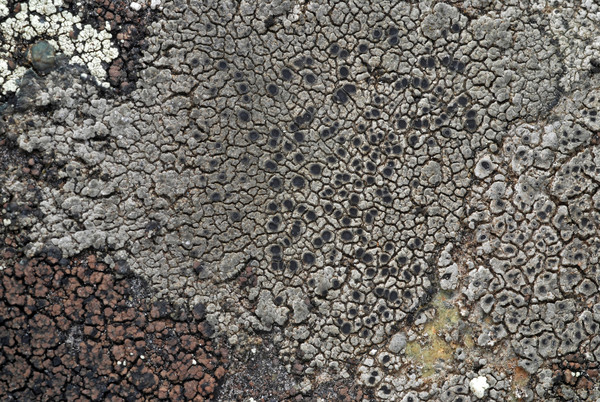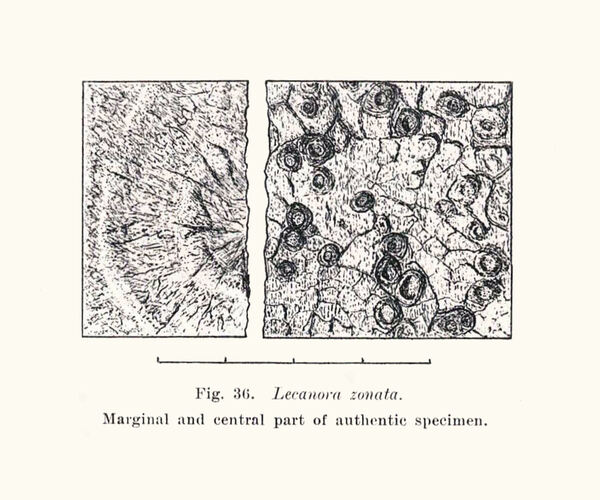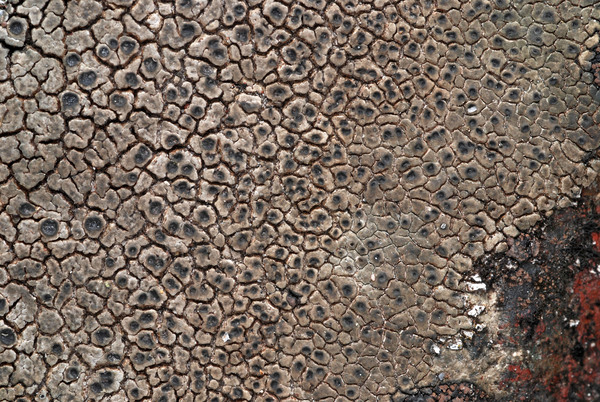Sagedia zonata Ach.
K. Vetensk-Akad. Nya Handl., 30: 165, 1809.
Synonyms: Aspicilia inconspicua (H. Magn.) Räsänen; Aspicilia litorea (H. Magn.) Räsänen; Aspicilia malmeana (H. Magn.) Ozenda & Clauzade; Aspicilia obscurascens (H. Magn.) Clauzade & Rondon; Aspicilia rolleana Hue; Aspicilia tenebrica; Aspicilia waldrastensis (H. Magn.) Clauzade & Rondon; Aspicilia zonata (Ach.) R. Sant.; Lecanora haerjedalica H. Magn.; Lecanora inconspicua H. Magn.; Lecanora litorea H. Magn.; Lecanora malmeana H. Magn.; Lecanora obscurascens H. Magn.; Lecanora pleiocarpa H. Magn.; Lecanora rolleana (Hue) Zahlbr.; Lecanora tenebrica H. Magn.; Lecanora tromsoënsis H. Magn.; Lecanora waldrastensis H. Magn.; Lecanora xyloxena H. Magn.
Description: Thallus crustose, episubstratic, dark grey-brown, often with a greenish or bluish hue, sometimes forming 1-2.5 mm broad concentric rings where the whitish to dark grey hypothallus is visible, irregularly rimose-areolate, the areoles 0.2-1 mm wide, flat to convex, smooth to verrucose, 0.2-0.4 mm thick. Cortex 25-35 µm thick, reddish brown in upper part; medulla white, I-. Apothecia lecanorine-aspicilioid, 0.2-0.7(-1) mm across, usually of different sizes in the same thallus, often crowded, immersed in convex areoles or somewhat raised, 1-4 per areole, with a concave to flat, black, sometimes slightly pruinose disc, a thin but prominent thalline margin and a distinct, black parathecial ring. Proper exciple to 50 µm thick, olivaceous brown in outer part, I+ pale blue; epithecium olive-brown to dark green, N+ emerald green, K+ brownish; hymenium colourless, 80-100 µm high, I+ yellowish green; paraphyses sparingly branched, anastomosing, submoniliform in upper part, 1.5-2 µm thick at mid-level, the apical cells up to 3.5 µm wide; hypothecium colourless, c. 35 µm high, I+ pale blue. Asci 8-spored, clavate, the thin outer coat K/I+ blue, the wall and the apical dome K/I-. Ascospores 1-celled, hyaline, broadly ellipsoid, (14-)17-20(-24) x 7-13(-15) µm. Pycnidia immersed, flask-shaped, with a dark punctiform ostiole. Conidia bacilliform, straight or rarely curved, 7-8 x c. 1 µm. Photobiont chlorococcoid. Spot tests: cortex and medulla K-, C-, KC-, P-, UV-. Chemistry: without lichen substances.
Growth form: Crustose
Substrata: rocks
Photobiont: green algae other than Trentepohlia
Reproductive strategy: mainly sexual
Poorly known taxon in need of further study
Commonnes-rarity: (info)
Alpine belt: very rare
Subalpine belt: very rare
Montane belt: extremely rare
Dry submediterranean belt: absent
Humid submediterranean belt: absent
Padanian area: absent
pH of the substrata:
1 2 3 4 5
Solar irradiation:
1 2 3 4 5
Aridity:
1 2 3 4 5
Eutrophication:
1 2 3 4 5
Poleotolerance:
0 1 2 3
Altitudinal distribution:
1 2 3 4 5 6
Rarity
absent
extremely rare
very rare
rare
rather rare
rather common
common
very common
extremely common
Loading data...
Occurrence data
Predictive map
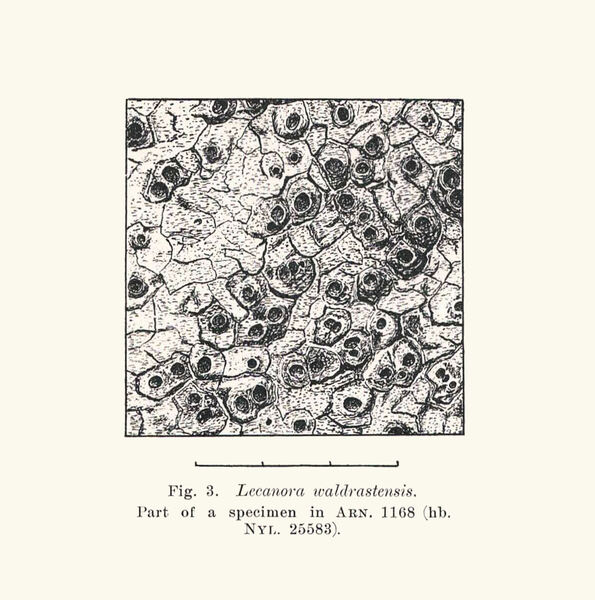
Magnusson A. H. 1939. Studies in species of Lecanora, mainly the Aspicilia gibbosa group. Kungl. Svenska Vetenskaps-Akademiens Handlingar, ser. III, 17, .5: 1-182.
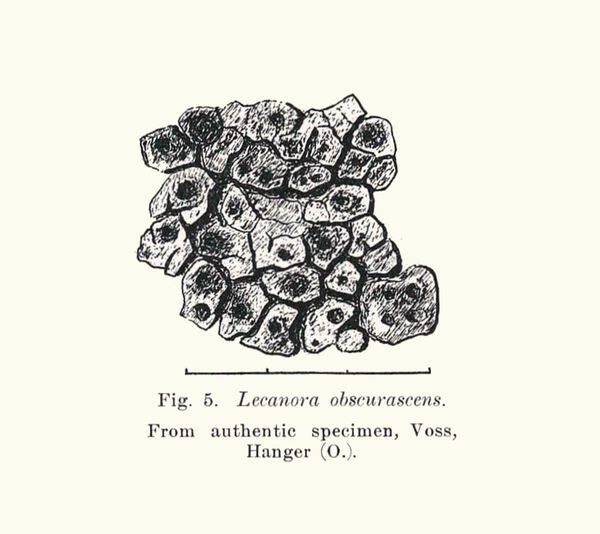
Magnusson A. H. 1939. Studies in species of Lecanora, mainly the Aspicilia gibbosa group. Kungl. Svenska Vetenskaps-Akademiens Handlingar, ser. III, 17, .5: 1-182.
Growth form: Crustose
Substrata: rocks
Photobiont: green algae other than Trentepohlia
Reproductive strategy: mainly sexual
Poorly known taxon in need of further study
Commonnes-rarity: (info)
Alpine belt: very rare
Subalpine belt: very rare
Montane belt: extremely rare
Dry submediterranean belt: absent
Humid submediterranean belt: absent
Padanian area: absent
pH of the substrata:
| 1 | 2 | 3 | 4 | 5 |
Solar irradiation:
| 1 | 2 | 3 | 4 | 5 |
Aridity:
| 1 | 2 | 3 | 4 | 5 |
Eutrophication:
| 1 | 2 | 3 | 4 | 5 |
Poleotolerance:
| 0 | 1 | 2 | 3 |
Altitudinal distribution:
| 1 | 2 | 3 | 4 | 5 | 6 |
Rarity
absent
extremely rare
very rare
rare
rather rare
rather common
common
very common
extremely common
Loading data...
Occurrence data
Predictive map

Magnusson A. H. 1939. Studies in species of Lecanora, mainly the Aspicilia gibbosa group. Kungl. Svenska Vetenskaps-Akademiens Handlingar, ser. III, 17, .5: 1-182.



